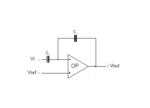bsaqycx
Newbie level 5
the opamp is used in switch-capacitor circuit and the gain is 1. However, how should I choose the value of C1?
Could C1 be considered to be the load of the amp? If so, the stability performance of opamp is affected.
If the opamp is a 2-stage miller-compensated op, which is the key point to the slew rate of this SC circuit, the driving ability of the opamp or the slew rate of the amp?
Could C1 be considered to be the load of the amp? If so, the stability performance of opamp is affected.
If the opamp is a 2-stage miller-compensated op, which is the key point to the slew rate of this SC circuit, the driving ability of the opamp or the slew rate of the amp?
